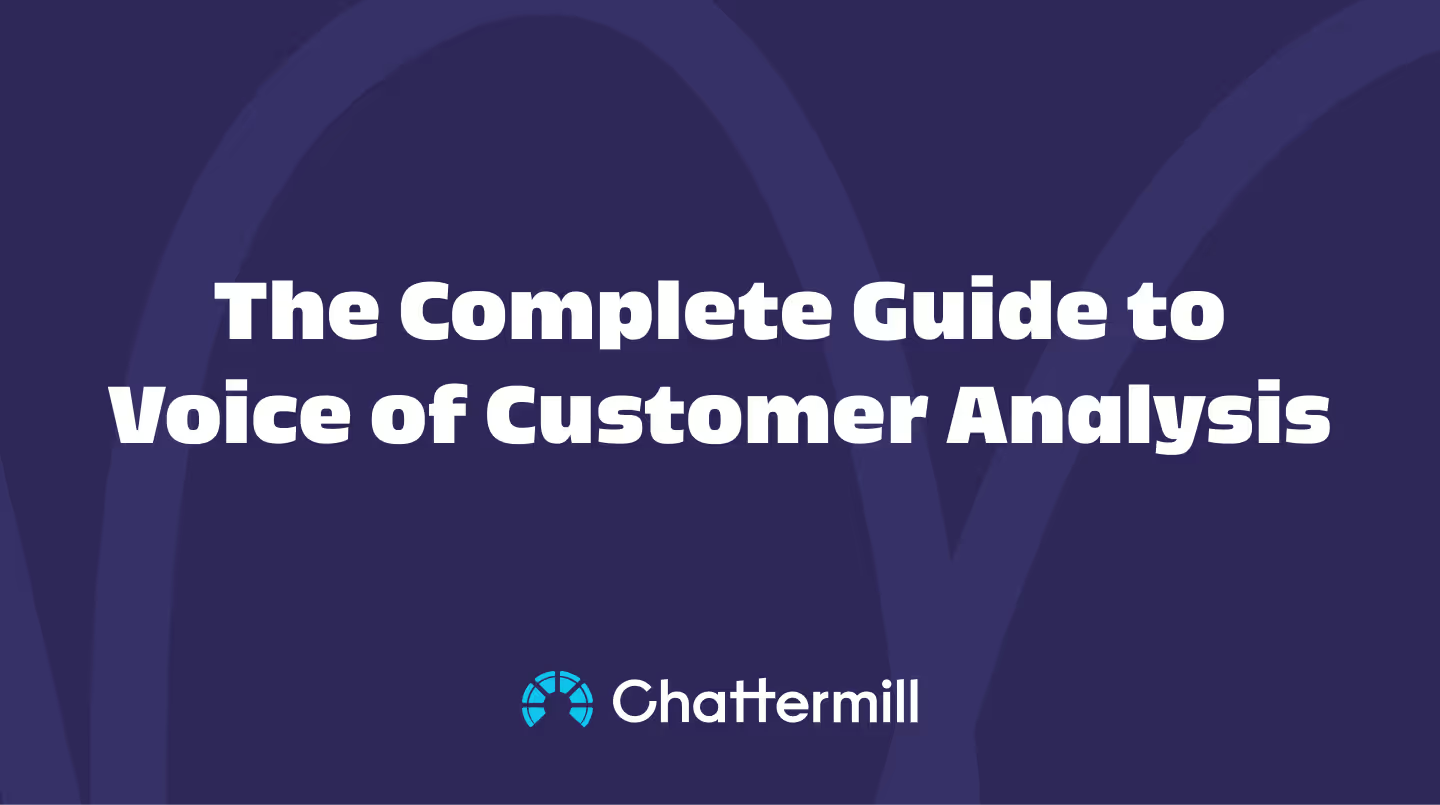Why Voice of Customer Analysis Matters
Your business is nothing without customers. To build loyalty, improve retention, and drive growth, you must listen to customer feedback and translate it into action.
That’s where Voice of the Customer (VoC) analysis comes in. Gathering customer data is only the first step. The real impact happens when you decode customer sentiment and uncover insights that shape smarter business decisions.
According to Harvard Business Review, companies that excel at customer experience consistently outperform competitors in revenue growth and customer retention. Similarly, HBR notes that customer experience is everyone’s responsibility, from marketing and product to leadership and frontline teams (HBR).
VoC analysis enables you to align every team with the customer’s perspective and build an organization that thrives on customer reality.
Types of Voice of the Customer Analysis
There is no one-size-fits-all. Most companies blend quantitative and qualitative methods.
- Quantitative data: Metrics like NPS, CSAT, CES, click-through rates, and web or social analytics.
- Qualitative data: Sentiment analysis, social media posts, customer interviews, and open-text survey responses.
Customer Surveys
Surveys are the foundation. NPS, CSAT, and CES uncover satisfaction, loyalty, and effort. The value depends on asking the right questions, not just yes/no answers.
Direct Feedback
Customer interviews, focus groups, and recorded support calls provide nuanced feedback and highlight pain points in context.
Social Media
Real-time conversations show what people say when they are unfiltered. VoC platforms like Chattermill aggregate this data and apply AI for sentiment analysis.
Website Behavior
Tracking visits, clicks, conversions, and drop-offs helps identify friction points in the digital journey.
Online Reviews
Third-party platforms like Trustpilot or App Store reviews reveal honest feedback that influences purchase decisions.
As Bain & Company highlights, AI is increasingly key to VoC analysis, automating sentiment detection and surfacing insights at scale.
What is Voice of the Customer Analysis?
VoC analysis is the structured process of analyzing feedback across surveys, reviews, conversations, and behavior data to reveal what customers truly need and expect. A successful Voice of the Customer program and methodology will provide you with all the customer insights you need to understand their preferences, pain points, and complaints. That powerful data enables you to make customer-centric, data-driven decisions which will improve business performance.
A successful program provides actionable insights to:
- Identify pain points and opportunities
- Drive improvements in products and services
- Strengthen customer loyalty
- Increase revenue impact
- Give teams real-time access to customer truths
Importantly, VoC analysis is not just about collecting data. It’s about using structured analysis, sentiment detection, and prioritization to create real change.
Benefits of Voice of the Customer Analysis
Done well, VoC analysis helps businesses:
- Discover unmet customer needs
- Improve targeting and personalization
- Identify customer journey friction
- Reduce churn and increase retention
- Optimize support, marketing, and product development
- Share insights across stakeholders
- Build a customer-first culture
Types of Voice of the Customer Analysis
There is no one-size-fits-all. Most companies blend quantitative and qualitative methods.
- Quantitative data: Metrics like NPS, CSAT, CES, click-through rates, and web or social analytics.
- Qualitative data: Sentiment analysis, social media posts, customer interviews, and open-text survey responses.
Customer Surveys
Surveys are the foundation. NPS, CSAT, and CES uncover satisfaction, loyalty, and effort. The value depends on asking the right questions, not just yes/no answers.
Direct Feedback
Customer interviews, focus groups, and recorded support calls provide nuanced feedback and highlight pain points in context.
Social Media
Real-time conversations show what people say when they are unfiltered. VoC platforms like Chattermill aggregate this data and apply AI for sentiment analysis.
Website Behavior
Tracking visits, clicks, conversions, and drop-offs helps identify friction points in the digital journey.
Online Reviews
Third-party platforms like Trustpilot or App Store reviews reveal honest feedback that influences purchase decisions.
As Bain & Company highlights, AI is increasingly key to VoC analysis, automating sentiment detection and surfacing insights at scale.
10 Steps to Voice of the Customer Analysis
Creating a VoC program requires discipline and consistency. Here’s how to take it from theory to execution:
1. Define the Question
Start by clarifying what you want to solve. Examples: Why has churn increased this quarter? How do customers feel about our new onboarding process? A focused question ensures you collect the right data instead of drowning in noise.
2. Gather Feedback
Pull insights from multiple channels: surveys, call logs, reviews, chat transcripts, and analytics. Use tools like Chattermill’s Customer Feedback Analytics to centralize feedback so you can see a unified picture of the customer journey.
3. Categorize and Organize
Raw feedback is messy. Organize it into themes like “pricing,” “support response time,” or “checkout experience.” This structure helps teams identify patterns faster and assign ownership.
4. Use Sentiment Analysis
Not all feedback is equal. AI-powered sentiment analysis highlights whether feedback is positive, neutral, or negative, and detects emotion at scale. This lets you act on issues before they escalate.
5. Spot Trends and Pain Points
Look for recurring issues across customer touchpoints. For example, multiple complaints about shipping delays could signal an operational bottleneck that needs urgent attention.
6. Quantify the Feedback
Go beyond anecdotes. Measure the frequency and intensity of issues to understand their impact. If 5% of your high-value customers mention the same problem, that’s a stronger signal than dozens of low-value complaints.
7. Prioritize Improvements
Use frameworks like Impact, Confidence, Ease (ICE) to decide which actions deliver the highest ROI. Focus on quick wins to build momentum, while also addressing strategic fixes that affect long-term satisfaction.
8. Share Insights Across Teams
VoC analysis shouldn’t live in silos. Sales, product, marketing, and customer support should all access dashboards tailored to their roles. Sharing insights cross-functionally ensures every department aligns with customer reality.
9. Close the Loop with Customers
Show customers you listened. If they asked for faster checkout, tell them what changes you made. Communicating updates builds trust, encourages future feedback, and strengthens loyalty.
10. Monitor and Evolve
Customer expectations shift constantly. Treat VoC as an ongoing loop of collection, analysis, and action. As Harvard Business School Online stresses, managing CX is not a one-time project but a continuous competitive advantage.
Voice of Customer Analysis Case Study: Monica Vinader
The luxury jewelry brand Monica Vinader used Chattermill dashboards to unify CX, support, and product feedback. By giving every team access to a single source of truth, they reduced churn and energized the business around data-driven decisions.
Explore more success stories on Chattermill’s Customer Stories hub.
Boosting the Bottom Line with VoC Analysis
VoC analysis is more than customer satisfaction reporting. It is the foundation of a customer-first business strategy. By listening, analyzing, and acting, you can:
- Create products people love
- Improve customer retention
- Outpace competitors
- Drive measurable revenue impact
Ready to turn customer feedback into business growth? Book a demo with Chattermill and see how real-time VoC analysis can transform your strategy.















